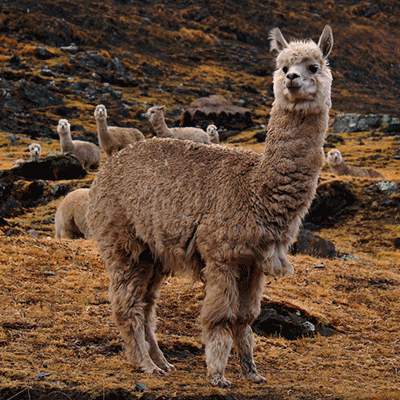
About Alpaca
The alpaca is a domesticated species of South American camelid and often confused with the llama. Although closely related, the alpaca is smaller than the llama and is not bred to be a working animal. Instead, they are farmed for their fiber, a strong material that becomes a valuable asset for any alpaca farmer.
Habitat
Alpacas primarily live in the central and southern Andes mountains in high plateau from Peru to Argentina. They are also domesticated across the world.
Diet
Their diet mostly consists of grasses and some woody shrubs.
Family Life
Alpacas have an incredible system of communication. Not only do they communicate with each other through sounds, but they also signal warnings and threats through their body language. Spitting is a common trait amongst alpaca groups, as they spit to show signs of distress, fear, or to display dominance. The males predominantly lead groups of alpacas, visibly showing dominance and controlling the rest of the herd.
Conservation Status
The conservation status of the Alpaca is classified as not evaluated.Threats
- There are no major predators of the alpaca; however, they come in contact with some of the same predators their close relatives, the guanaco and the vicugna, often face. These predators include domestic dogs, Andean foxes, condors, pumas, coyotes, wolves, and large cats.
- Most attacks will be on young, sick or old animals, as alpacas are vigilant and will fiercely defend themselves with their hooves and by spitting their stomach contents into the face of a predator.
Facts about Alpaca
Class:
Mammalia (mammals)Order:
Artiodactyla (even-toed ungulates)Family:
Camelidae (camels, llamas, etc.)Genus:
Lama (alpacas, guanacos, and llamas)Species:
Lama pacosLife Span:
15 – 20 yearsSize:
3 – 4.5 feet to shoulders (0.9 – 1.3 m)Weight:
121 – 143 lbs (55 – 65 kg)Length:
3.9 – 7.4 feet (1.2 – 2.2 m)
Fun Facts
- Studies on different archeological sites in South America suggest that alpacas were domesticated approximately 6,000 years ago.
- What stinks? Alpaca dung is used for a variety of different purposes including fertilizer and fuel for fires.
- It’s not fur, it’s fiber! Fiber is the main product derived from alpacas and is warmer and stronger than wool.